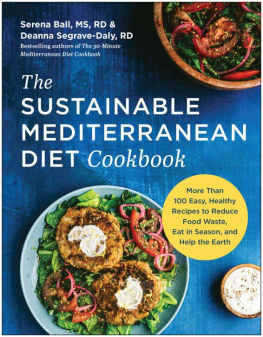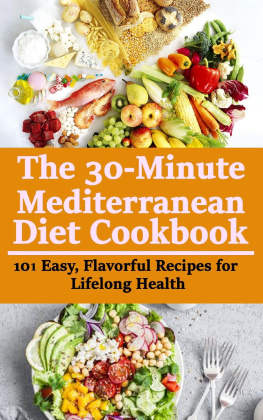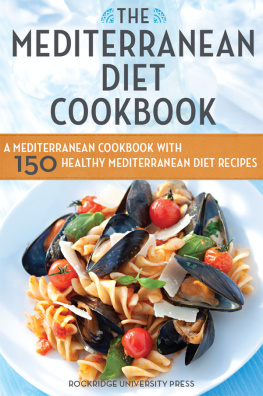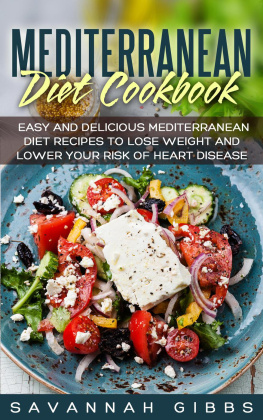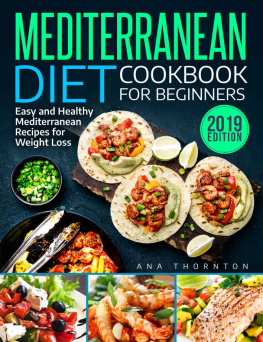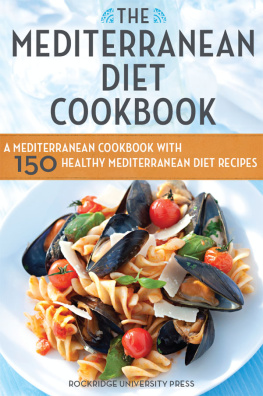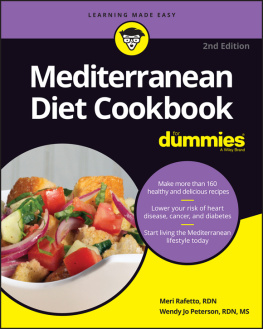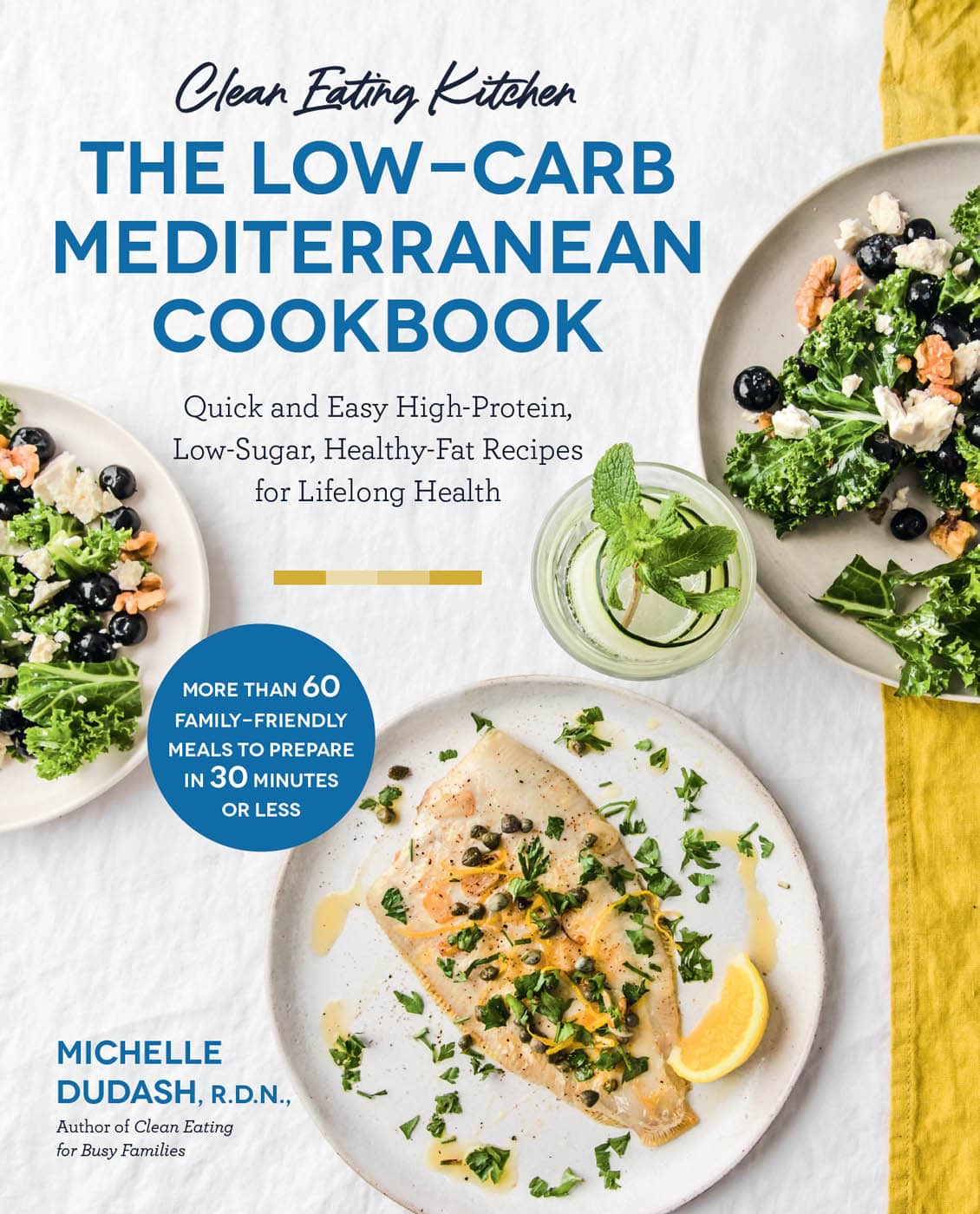Contents
Page List
Guide
Cover
Clean Eating Kitchen
THE LOW-CARB
MEDITERRANEAN
COOKBOOK
Quick and Easy High-Protein,
Low-Sugar, Healthy-Fat Recipes
for Lifelong Health
MICHELLE DUDASH, R.D.N.,
Author of Clean Eating for Busy Families
Contents
Introduction
Why I Wrote This Book for You
Through my years of working as a cookbook author, dietitian, recipe and product developer, television personality, private and personal chef, caterer, and food writer, Ive observed one constant: the majority of adults reach for protein foods the most and starchy foods the least. (Okay, except French fries.)
This is in line with the many people I have talked with about their eating habits. From surgeons to stay-at-home moms to hair stylists to sales executives, they strive to build the bulk of their plate with protein foods and non-starchy vegetables. These people report feeling their best when on a low-carb eating regimen. As a registered dietitian and nutritionist for twenty years, I have discovered that there is not one perfect eating plan that works for everyones DNA, culture, budget, lifestyle, and metabolism. I encourage people to find the eating style that they can stick to and enjoy for the long term that makes them feel good, both mentally and physically, while keeping chronic disease and inflammation at bay.
Despite good intentions, however, I see smart people dependent on highly processed, fatty meats and cheese to reach daily protein goals while in pursuit of a smaller waistline and blood sugar control. The problem is that people who eat more of these foods may then be putting themselves at an increased risk for high cholesterol, heart disease, stroke, cancer, and digestive issues, to name a few. Luckily, there is a better to go about this. You can achieve results by following the top eating pattern ranked year after year by credentialed medical professionals: the Mediterranean diet. However, this can be improved even further by tapering back on refined grains and sugar, an alternative plan known as the low-carb Mediterranean diet.
These factors, in addition to eating my way through numerous Mediterranean countries, inspired me to write this book for you, combining the beautiful, nourishing food of this region, while scaling back on carbs to adapt to modern-day eating preferences.
Bon apptit. Buon appetito. Buen provecho.
Chef Michelle Dudash, R.D.N.
Low-Carb Mediterranean Know-How:
What It Is, Who Its for, and How to Make It Work for You
Enjoying low-carb recipes doesnt have to be an all-the-time or all-or-nothing proposition. This chapter details how to fit low-carb recipes into your routine and in a way that works for your lifestyle.
My Mediterranean Background
It all began for me in the kitchen, of course. My Lebanese grandmother and her mother introduced me to the foods of their native country. There was always amazing, homemade food at the ready upon walking into either of their kitchens. They were the OGs of meal prep! From mostly parsley tabbouleh to lettuce salad with fresh lemon-mint vinaigrette to stuffed grape leaves, you would have never guessed I was growing up in a town of 36,000 people in the state of Wisconsin in the 1980s. (Shout-out to my hometown of Fond du Lac, Wisconsin, and also home to a group of Lebanese immigrants.)
After earning degrees and certifications as a registered dietitian nutritionist and Le Cordon Bleu chef in my early twenties, my next goal was to travel. Over the years, with my husband or colleagues, I have sought out various Mediterranean cities, towns, and countrysides spanning Italy, France, Monaco, Spain, and Croatia, with a top goal of devouring everything in sight, trying new foods to educate my palate. I enrolled in cooking classes in these countries, visited food production plants, and toured food markets. I sipped my way through some wineries, too. My travels have certainly influenced how I build my plate, grocery shop, cook, entertain, and feed my family. And I still have many Mediterranean countries left to visit, like Greece, Turkey, Israel, and more!
About the Mediterranean Diet
Originally introduced in 1993 by the Harvard School of Public Health, the Oldways Preservation and Exchange Trust, and the European Office of the World Health Organization, the Mediterranean diet went on to be added to the USDAs Dietary Guidelines for Americans 20152020 as a recommended meal plan option, brushing elbows with MyPlate, the modern version of the Food Guide Pyramid. This was a pretty big deal because when the government endorses something, you know it has gone through many hoops and levels of approval and scrutiny to earn that spot. Medical professionals, including registered dietitians, love the Mediterranean diet, too. The U.S. News & World Report has ranked the Mediterranean diet as Best Diet Overall in 2020 (third year in a row), second in Best Heart-Healthy Diet, first in Best Diabetes Diet, first in Best Diet for Healthy Eating, and first in Easiest Diet to Follow.
Grains, vegetables, and fruits lie at the foundation of the traditional Mediterranean Food Pyramid; however, the reality is that a lot of us are trying to avoid excessive amounts of starchy foods like pasta, rice, and bread in order to lose weight, control blood sugar levels for diabetes management or prevention, feel less bloated, and feel better in general. The good news is that you can still enjoy some grains, especially the whole-food versions, in moderation. It neednt be the center of the plate.
The low-carb Mediterranean diet delivers the best of both worlds, satisfying a mostly plant- and seafood-based regimen that is higher in protein and heart-healthy fats while being lower in carbs, but focusing on high-quality carbs. This book combines the healthiest and most crave-worthy ingredients and flavors of the Mediterranean diet that are sure to induce wanderlust, including vegetables and fruits, herbs and spices, some legumes, extra-virgin olive oil, nuts and seeds, seafood, some dairy and poultry, a bit of red meat, and some whole grains here and there.


